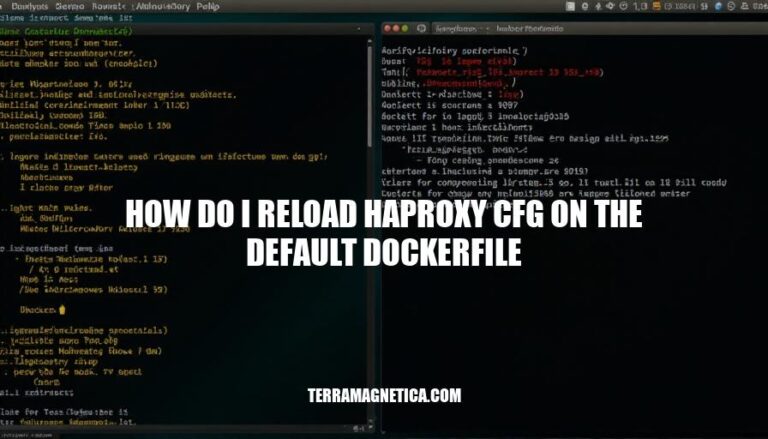


When operating HAProxy within Docker, reloading its configuration without causing downtime or service interruption is crucial. This ensures high availability and seamless updates, important for load balancers in production. Understanding ‘how do I reload HAProxy cfg on the default Dockerfile’ is key for maintaining efficient, uninterrupted service.
This competence is necessary to handle configuration changes on-the-fly, preserving the stability and reliability of your applications. It’s vital to ensure smooth deployment and management in dynamic environments.
To set up the Docker environment and configure HAProxy, follow these steps:
Install Docker: Ensure Docker is installed on your machine. You can download it from the official Docker website.
Create a Dockerfile: Create a Dockerfile to build the HAProxy image. Here’s an example Dockerfile:
# Use HAProxy base image FROM haproxy:2.3 # Copy HAProxy configuration file COPY haproxy.cfg /usr/local/etc/haproxy/haproxy.cfg # Expose ports EXPOSE 80 443 # Command to run HAProxy CMD ["haproxy", "-f", "/usr/local/etc/haproxy/haproxy.cfg"]
Build the Docker Image: Run the following command to build the Docker image:
docker build -t my-haproxy .
Run the Docker Container: Start the container with the following command:
docker run -d --name my-running-haproxy my-haproxy
Reload HAProxy Configuration: To reload the HAProxy configuration without restarting the container, send a SIGHUP signal to the container:
docker exec my-running-haproxy haproxy -f /usr/local/etc/haproxy/haproxy.cfg -p /var/run/haproxy.pid -sf $(cat /var/run/haproxy.pid)
A well-configured Dockerfile is crucial for the reloading process because it ensures that the HAProxy configuration file is correctly copied and set up within the container. This setup allows for seamless updates to the HAProxy configuration without downtime.
Create a Dockerfile: Start by creating a Dockerfile in your project directory.
Base Image: Use an appropriate HAProxy base image. For example:
FROM haproxytech/haproxy-ubuntu:3.0
Copy Configuration File: Copy your HAProxy configuration file into the container. For example:
COPY haproxy.cfg /usr/local/etc/haproxy/haproxy.cfg
Build the Docker Image: Build the Docker image using the Dockerfile. Run the following command in your terminal:
docker build -t my-haproxy .
Run the Container: Run the container with the following command:
docker run -d --name my-running-haproxy my-haproxy
Reload HAProxy Configuration: To reload the HAProxy configuration, send a SIGHUP signal to the container. Use the following command:
docker exec -it my-running-haproxy haproxy -f /usr/local/etc/haproxy/haproxy.cfg -p /var/run/haproxy.pid -sf $(cat /var/run/haproxy.pid)
Persist Configuration: To persist the configuration, mount a volume when running the container. For example:
docker run -d --name my-running-haproxy -v /path/to/etc/haproxy:/usr/local/etc/haproxy:ro my-haproxy
Reload Configuration on Change: To automatically reload the configuration when the file changes, use environment variables. For example:
docker run -d --name my-running-haproxy -v /path/to/etc/haproxy:/haproxy-data:ro -e CONFIG_FILE=haproxy.cfg -e EXTRA_WATCH_FILES=/haproxy-data/certs my-haproxy
By following these steps, you can modify your Dockerfile to include HAProxy configuration reload functionality.
To test the reloaded HAProxy configuration in a Dockerfile, follow these steps:
Create a Dockerfile: Start by creating a Dockerfile that copies your HAProxy configuration file into the container.
FROM haproxytech/haproxy-ubuntu:3.0 COPY haproxy.cfg /usr/local/etc/haproxy/haproxy.cfg
Build the Docker Image: Use the docker build command to create the Docker image.
docker build -t my-haproxy .
Test the Configuration: Before running the container, test the HAProxy configuration file.
docker run -it --rm my-haproxy haproxy -c -f /usr/local/etc/haproxy/haproxy.cfg
Run the Container: If the configuration file passes the test, start the container.
docker run -d --name my-running-haproxy my-haproxy
Reload the Configuration: To reload the HAProxy configuration without restarting the container, send a SIGHUP signal to the container.
docker kill -s HUP my-running-haproxy
Check for Syntax Errors: Use the -c flag to check the configuration file for syntax errors before reloading.
haproxy -c -f /usr/local/etc/haproxy/haproxy.cfg
Review Logs: Check the HAProxy logs for any errors or warnings.
docker logs my-running-haproxy
Verify Ports: Ensure that the ports defined in the configuration file are correctly exposed and mapped in the Docker run command.
docker run -d --name my-running-haproxy -p 8080:80 my-haproxy
Use Systemd Commands: If you’re using a systemd-based system, you can use systemctl commands to manage the HAProxy service.
sudo systemctl status haproxy.service sudo systemctl reload haproxy.service
Check Systemd Logs: Use journalctl to view detailed logs for troubleshooting.
sudo journalctl -u haproxy.service
By following these steps and tips, you can ensure that your HAProxy configuration is correctly reloaded and troubleshoot any issues that arise.
To maintain high availability and seamless updates for load balancers in production, it’s crucial to know how to reload HAProxy configuration without causing downtime or service interruption. This involves understanding the process of reloading HAProxy cfg on the default Dockerfile.
Troubleshooting tips are also provided to ensure that HAProxy configurations are correctly reloaded and any issues are addressed.